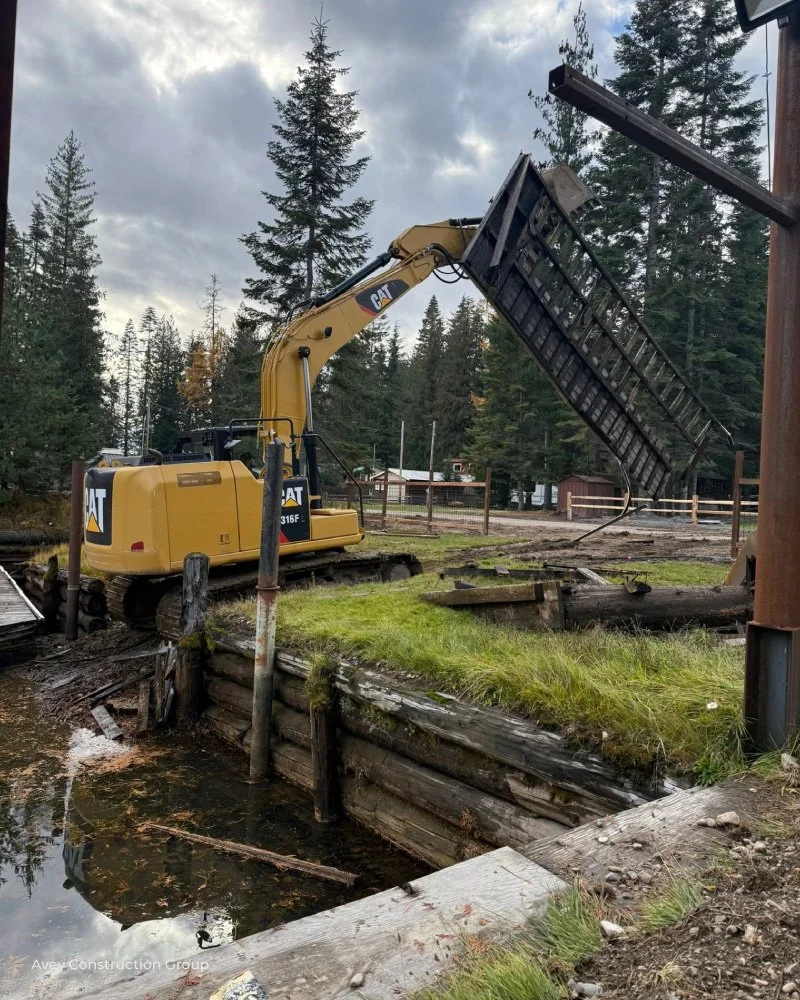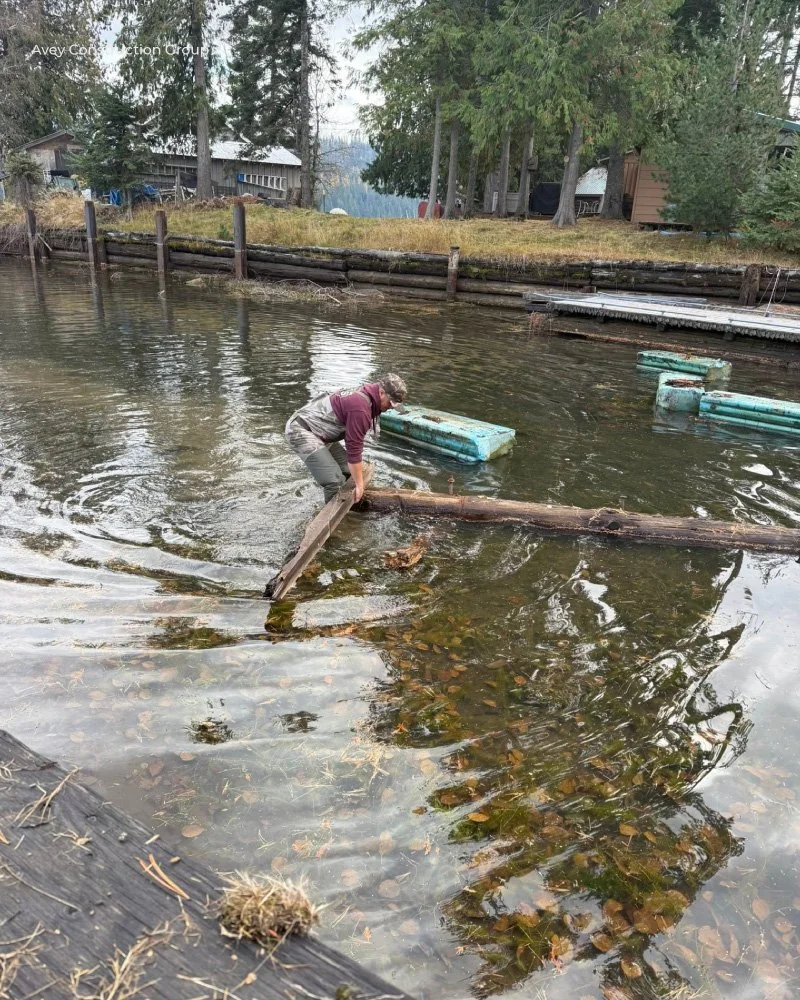Shoreline Excavation and Dock Replacement: What to Know Before Work Begins on North Idaho Lakes
Shoreline construction on North Idaho’s lakes, such as Priest, Coeur d’Alene, and Pend Oreille, requires careful planning and coordination. Projects involving dock demolition and shoreline excavation include far more steps than a typical excavation job, especially when working near the waterline. As contractors experienced with lakefront work, we’ve outlined how the process generally works and what property owners can expect when preparing a site for a new dock system.
Why Shoreline Excavation Requires a Defined Process
North Idaho lakes are environmentally sensitive, and shoreline work must be completed in a controlled, carefully sequenced manner. A structured approach provides:
A predictable schedule and scope
Reduced environmental impact and erosion
Safe, organized workflow during demolition and excavation
Compliance with shoreline rules and waterway regulations
How the Shoreline Excavation and Dock Replacement Process Works
Below is the typical workflow when partnering with a qualified shoreline excavation contractor.
Step 1: Site Evaluation and Project Planning
A detailed site evaluation determines how the shoreline can be accessed and what the demolition and excavation will require.
During this assessment, the contractor will:
Walk the site and evaluate shoreline stability and access limitations
Identify excavation boundaries near or below the high-water mark
Review project goals such as dock removal, shoreline cleanup, or preparing for a future dock system
Deliverable to expect:
A plan outlining equipment needs, access strategy, and the overall approach.
Step 2: Scope Confirmation and Work Strategy
After the evaluation, the contractor establishes a strategy that ensures safe and efficient dock removal and shoreline excavation.
This includes:
Determining whether access will be land-based, barge-based, or a hybrid
Planning excavation, soil removal, and material staging
Scheduling work around lake levels and environmental conditions
Property owners gain clarity on sequencing and expected timelines.
Step 3: Preparation of Shoreline and Construction Access
Before demolition and excavation begin, the site must be properly set up.
Access setup may include:
Temporary access routes or pads
Barge mobilization if land access is limited
Safe staging areas for dock materials and equipment
Environmental protections typically installed:
Silt fencing and water-side containment
Preservation or temporary relocation of shoreline vegetation
Runoff and sediment control measures
This preparation protects both the shoreline and the lake.
Step 4: Shoreline Excavation and Grading
With the site prepared, excavation work is performed in a controlled sequence.
Typical excavation tasks include:
Removing unstable or damaged shoreline material
Grading or reshaping the bank for stability
Excavating areas needed to support the future dock foundation or anchoring system
Contractors use equipment sized appropriately for tight, sensitive shoreline conditions to prevent unnecessary disturbance.
Step 5: Dock Demolition and Site Preparation for a New Dock
If an old dock is present, demolition is the next step. For many projects—including those like our recent work at Kaniksu—dock removal is completed to prepare the site for a new dock system.
Removal phase includes:
Dismantling old dock structures
Safely removing anchoring components
Responsible disposal of dock materials
Clearing the shoreline for future installation
Once demolition is complete, the shoreline is left ready for the next phase of construction when conditions and timing allow.
Step 6: Final Stabilization and Site Restoration
After excavation and dock removal, the shoreline is stabilized to protect long-term site integrity.
This may include:
Backfilling and compacting disturbed areas
Replanting or restoring native vegetation
Adding erosion-control measures if needed
Stabilization ensures the shoreline remains secure until the new dock installation begins.
Permits and Approvals for Shoreline Work in North Idaho
Shoreline excavation and dock demolition require permits before work can begin. These approvals protect water quality, prevent erosion, and ensure shoreline changes comply with local and state regulations.
Why Permits Are Required
Any work near or below the high-water mark—such as excavation, grading, or dock removal—requires review to protect the lakebed and shoreline. Permits also ensure that future dock installations meet safety and regulatory standards.
Who Reviews Shoreline Projects
Depending on location, approvals may involve:
County planning departments
City planning departments (when properties fall within city boundaries)
Idaho state agencies for docks or in-water work
Most shoreline projects involve at least county and state review.
How Professionals Handle the Process
A professional excavation contractor typically manages the full permitting process, including:
Identifying required permits
Preparing drawings, site documentation, and work descriptions
Submitting applications
Coordinating construction timing with approval timelines
Ensuring permit conditions are followed during dock removal and excavation
This streamlines the project and reduces delays.
Expected Permit Timelines
Review times vary, but most shoreline permits take several weeks. Starting early keeps the project on schedule.
Start With a Clear Plan for Efficient Lakefront Construction
A structured process keeps shoreline excavation and dock removal efficient, safe, and compliant. From Priest Lake to Coeur d’Alene, working with an experienced shoreline excavation contractor ensures your project is prepared correctly—whether you’re removing an existing dock, reshaping the shoreline, or getting the site ready for a new dock system next season.
If you're planning shoreline improvements anywhere in North Idaho, a professional site evaluation is the best first step.
FAQ: Shoreline Excavation and Dock Replacement for Developers
-
Yes. Any excavation, grading, dock removal, or new dock installation on North Idaho lakes requires permitting before work can start.
-
Most shoreline permits take a few weeks to process. Starting early helps keep your project on schedule.
-
No. A professional excavation contractor typically manages the entire permitting process, including documentation, submissions, and communication with reviewing agencies.
-
Yes. In most cases, demolition and new dock installation are reviewed together as part of the same project scope.
-
Most projects run 6–12 weeks depending on scope, site access, and seasonal conditions.
-
Professional planning minimizes disruption, but contractors will stage equipment and work hours to reduce impact during peak season.
-
Only if land access is limited. Your contractor will determine this during the initial site evaluation.
-
Yes, within defined limits. A contractor will outline safe options that maintain shoreline stability.
-
Composite and aluminum systems tend to offer the best durability and lowest ongoing maintenance.



